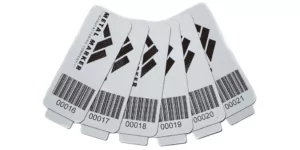Leaking valves, pumps, and pipes are a major concern for industrial organizations. Not only do leaks present a safety risk, they are also a major source of pollution.
As such, the Environmental Protection Agency (EPA) has set regulations in place to prevent this hazard.
The Leak Detection and Repair System (LDAR) ensures companies effectively prevent and stop leaks. Metal LDAR tags provide a durable method for identifying and monitoring leaks.
Regulations
Faced with increasing pollution from industrial-type organizations, the EPA set forth the Clean Air Act of 1963. This federal mandate set a nationwide standard for controlling air pollution.
Specifically, the law targets industrial facilities which emit volatile organic compounds and air pollutants.
This act set forth the initial implementation of the Leak Detection and Repair (LDAR) program.
LDAR focuses on valves, pumps, pressure relief systems, compressors, connectors, etc. Essentially any type of system which may leak volatile compounds or pollutants.
Chemical manufacturing facilities, oil refineries, and other producers rely on metal LDAR tags to identify and track any violations of these laws. LDAR techs monitor the levels of exposure the facility produces
When a leak is detected, a compliant facility must repair the leak within a few days. If the leak is not fixed in a timely manner, the organization can be hit with hefty fines and other penalties.
What Causes Leaks?
Leaks are a common problem faced by industrial operations. As mentioned, valves, pressure reliefs, pumps, connectors, flanges, Etc., can all be sources for leaks. The cause can be as mundane as a faulty O-ring on a valve, or as concerning as structural failure of a pump system.
Benefits of Utilizing the LDAR System
Beyond simply meeting federal and state regulations, there are additional benefits for organizations to utilize the LDAR system.
Reduced Product Loss
A major issue for chemical plants or oil refineries, leaking doesn’t just mean a pipe or pump to fix; it means wasted product. Detecting and stopping leaks sooner can prevent extremely costly losses.
Safety
The goal of any organization is to provide and promote the safest workplace possible for its employees. Leaking pipes and valves can put workers at risk. This can be from exposure to hazardous chemicals or airborne substances, or even as simple as a slippery walkway from water leakage.
The LDAR system forces organizations to take these leaks seriously, and address them as soon as possible. Quick action can mean the difference between a safe environment and employee injury.
LDAR Tagging
Every component that falls within the LDAR regulations must be assigned a unique identification number. This number must be logged into a system for tracking the company’s LDAR program. Most organizations elect to use a physical tag on each logged component. This makes the system significantly easier to maintain. Some states specifically require the physical tag as well.
When a valve or other component is repaired or serviced it must be logged in the system.
The best way to ensure compliance with the EPA regulations is to physically mark all regulated components with durable metal ID tags, each with their own unique number.f
Electronic data systems are a great option to streamline the process. Barcode tags can be applied to equipment to make the logging procedure as simple as a quick scan. AIDC technology can help eliminate human error as well. The EPA actually recommends these systems in their best practices for compliance.
LDAR repair tags track not only leaks, but the entire process of detection and repair. This includes the date of repair, cause of damage/failure, and success of the repair is monitored as well.
Marking Processes
Photo Anodization
The best process for adding barcodes, photo anodization is very popular for LDAR tagging. Instead of printing or indenting the tag, photo anodization embeds the design beneath layers of aluminum.

This process offers 20+ years durability even in harsh conditions. Exposure to water or other leaks will not cause the design to wear.
Any type of design or barcode can be added to this type of tag. In addition, the anodized material can be color coded to indicate different valve types, or varying chemicals.
Stamping/Embossing
Another commonly used process for valve marking, the stamping and embossing processes physically indent or raise a design in the material.
While the indentations are incredibly durable, they are limited in what they can include. Unlike photo anodization, barcodes cannot be added using these marking processes.
These marking styles are very heavily used for other valve identification applications.
Wrap-Up
The Leak Detection and Repair guidelines set forth by the EPA serve two main purposes: ensuring safety, and reduces pollution.
Organizations which fit into the requirements must comply with the LDAR program. While this may seem like a burden, it actually benefits all parties involved.
The LDAR system will help the operation run in a more effective and organized manner. Metal LDAR tags provide a long-lasting and simple solution for complying with the EPA’s regulations.